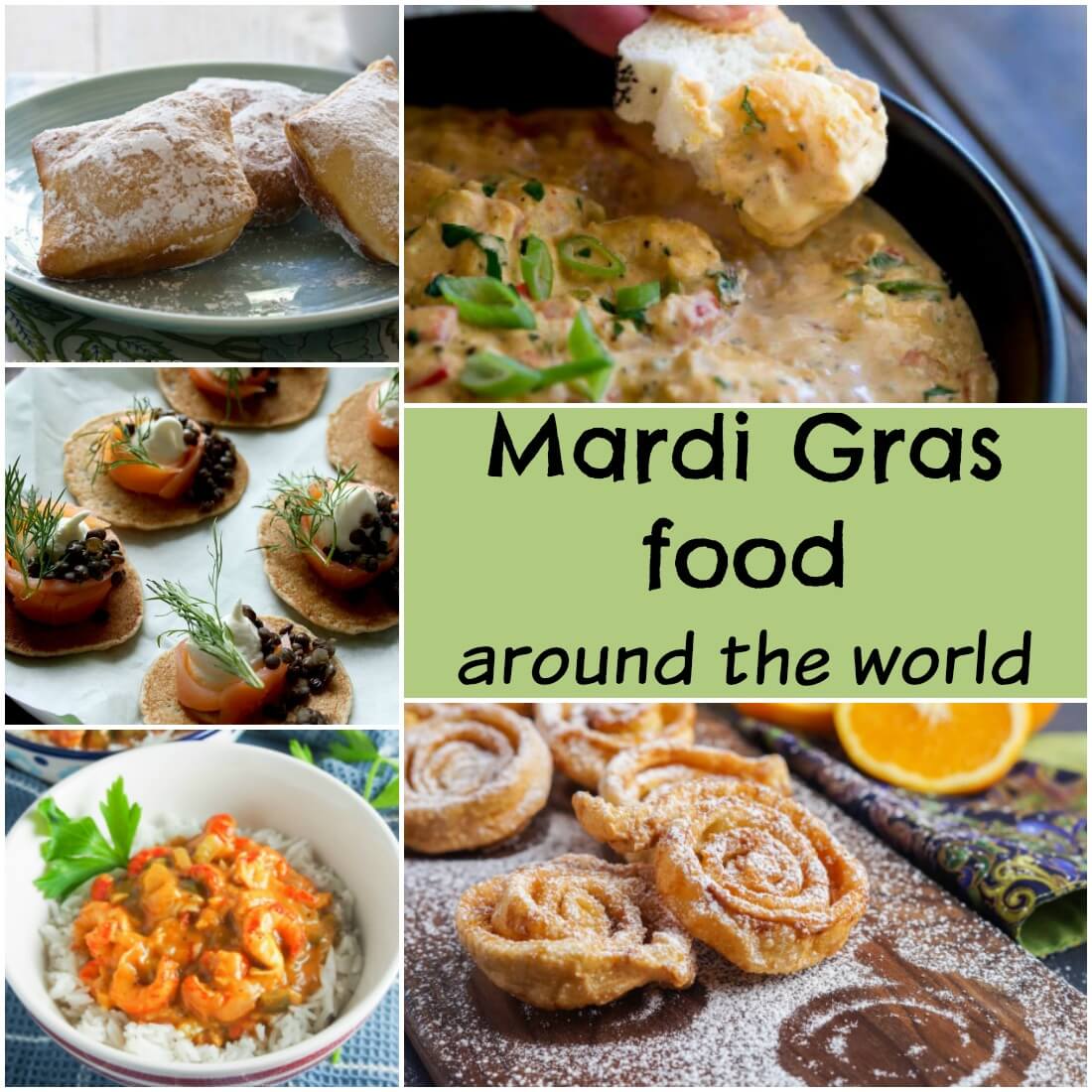
In the US, everyone talks about Mardi Gras and thinks of New Orleans. In terms of Mardi Gras food, that means king cake, beignets and many Creole/Cajun classics. But where I grew up we ate pancakes and called it Shrove Tuesday.
Many other countries have yet more names for the day and a whole range of food traditions. Here's a roundup of how some different countries celebrate Mardi Gras/ Carnevale/ Karnival and some of the delicious treats you could enjoy. You'll find a few recipes from here as well as other blogger friends. Why not try some at home?
Mardi gras - a New Orleans tradition
Mardi Gras in the US is most famously celebrated in New Orleans. It’s a time when many celebrate with large pots of their favorite dishes such as gumbo, crawfish efouffee and jambalaya. You’ll also see special local treats like oysters Rockefeller, hot Louisiana shrimp dip, shrimp remoulade and muffuletta sandwiches.
There are plenty of sweet treats as well. The most common are beignets and king cakes, as well as bananas Foster, washed down with a hurricane cocktail.
Buzzing Brazil
Brazil has some, if not THE biggest celebrations in the world, with the Rio Carnival the best known. It's far from the only one and each has it's own character, but all full of color. Carnival is often an excuse to enjoy one of Brazil’s most famous dishes, feijoida, a bean and meat stew. Especially on the coast, there will be plenty of fish dishes such as moqueca baiana, a fish stew.
You'll also see lots of street food such as grilled meat on sticks, ‘pao de queijo’, cheese bread balls, and sweet treat like brigadeiros (above).
Not so boring Northern Europe
In the UK, Mardi Gras is officially called Shrove Tuesday, but for many people it's better known as pancake day. I, like many people growing up in the UK, loved devouring simple thin British pancakes with sugar and lemon (above).
Russia also goes in for pancakes, sometime plain or other times small buckwheat pancakes with toppings like smoked salmon. Swedes enjoy an indulgent cream bun, semlor.

Germany might have the longest celebration period, with it starting on November 11th and running right through the winter. The festivities go by different names in the different regions (Fasching, Karneval, Fastnacht) and there are some local favorite foods as well as some common favorites - pretzels, sausages and jam-filled doughnuts (known as Krapfen, Fasnacht or Pfannkuchen).
You’ll also see festival/cold weather favorites like gluhwein, German mulled wine (above), German potato pancakes and gulash.

An island affair
Trinidad and Tobago battles Brazil for the biggest festivities with big, colorful and lively processions. Favorite foods include corn soup, roti bread and doubles, curried chickpeas over a flatbread called barra.
You’ll also see other local favorites like pineapple chow (above, or other fruits) where the fruit is seasoned with chili, cilantro and garlic.

Cyprus dedicates two whole weeks to the celebration - one for meat and one for cheese. For meat, think souvlaki, lamb kebabs, and tavva, a lamb, potato and tomato stew. You'll also find Greek/Cypriot favorites like youvetsi (above), a lamb or beef stew with orzo, and moussaka, a kind of lasagna with eggplant.
Cheese naturally includes the nation’s favorite, halloumi (you could try my halloumi burger to get in the spirit, even if it's less traditional), as well as cheese ravioli, flaunes and bourekia, cheese-filled pastries.
Colorful Carnevale in Italy
Italy’s Carnevale may be most famously celebrated with masks and parades in Venice but you'll find many other celebrations across the country. Much of the food are sweet street foods with things like tagliatelle dolci de carnivale (sweet tagliatelle, above), doughnut hole-like castagnole and fritelle, a softer version more like fried pancakes.
Different places also have local traditional dishes, such as schiacciata alla fiorentina (a kind of orange-flavored sweet bread/cake) in the Florence region. You’ll also find various pasta dishes, especially lasagna, tortellini, gnocchi and sweet ravioli with ricotta filling.
Mardi gras food comes in many different forms, both sweet and savory, but as you can see there are lots of delicious treats wherever you are. So, what are you going to try first?
Remember to pin for later!







Laura Dembowski
I often struggle with what to make for mardi gras, so this post was super informative!
Caroline's Cooking
Thanks Laura, glad it gave you some ideas!
Cynthia |What A Girl Eats
Isn't it fun to see how everyone celebrates the same holiday around the world? Thank you for including my New Orleans Beignets!
Caroline's Cooking
I agree, there's a lot of variation but some common themes, too. Looking forward to giving your beignets a try!
Christina | Christina's Cucina
Wonderful recipes! Thanks for including my Semlor!
Caroline's Cooking
You're welcome!